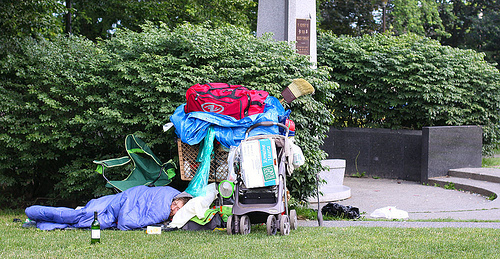By James Inglis (Contributor) – Email
Print Edition: February 22, 2012
According to the 2011 Fraser Valley Regional District Homelessness Survey, there are 117 people that are homeless in Abbotsford.
The report linked homelessness to inadequate affordable housing, poverty, drug addiction, mental health issues and relational breakdown. The report defined homeless persons “as persons with no fixed address, with no regular and/or adequate nighttime residence where they can expect to stay for more than 30 days.” Is this how others see the homeless? Is this the perception of the public, or the volunteers and professionals who interact with the homeless?
Deb Lowell, the Public Relations Director for the Salvation Army Community Ministries in Abbotsford believes the public perception of the homeless is somewhat different.
“I believe the public in general has a misconception of the homeless population. I often hear remarks like ‘they should just get a job like the rest of us!’ or ‘why should I throw good money after bad? Nothing ever changes,’” she said. Lowell believes the misconceptions stem from ignorance. The Salvation Army’s Meal Centre, Emergency Shelter and the Food bank serve more than 3500 clients each and every month. People in need of services are not just those the report identifies as homeless. Lowell said the number of others in need, such as the working poor, seniors, mentally ill, single parent families make up the majority of the people the Salvation Army serves.
According to Lowell, “Very often, our clients have multiple barriers including addiction issues and mental health issues,” and she believes that education of the public and other groups is important in changing the perception about the homeless and others in need.
The Abbotsford Police Department (APD) has ongoing interaction with the homeless in Abbotsford. Constable Ian MacDonald, the police department’s Public Information Officer (PIO), said the police department “does not officially define a homeless person… there is nothing criminal about being homeless and there are no statutes that govern it. There are statutes that govern behaviors such as camping illegally and loitering but those actions are absolutely not unique to homeless persons.” Cst. MacDonald believes that, “when dealing with marginalized persons it is often best to allow people to define themselves.”
Cst. MacDonald acknowledged that the police interact several times per day with individuals who classify themselves as homeless, but he stated “most of our interactions involve either regular conversation or the offer of resources via government agencies or Good Samaritan organizations.” Cst. MacDonald noted that the APD “believes that this [homelessness] is a societal and community issue, not an issue of criminality.”
Marguerite Mitchell, an “I’m pushing 90”-year-old volunteer working with the homeless believed the public does have a negative perception of the homeless. She believes the public should talk to the homeless and hear their stories.
“These are not lazy people or people with no initiative,” she said. “Very often they have a story that shakes you right to your toes, which is what compels me to go out and feed them.” Mitchell initially volunteered with a local church to provide a weekly breakfast for the homeless at Abbotsford’s Jubilee Park, but complaints from the Abbotsford Downtown Business Association and others resulted in the church being compelled by the City of Abbotsford to stop its breakfast program. Bob Bos, the former President of Abbotsford’s Downtown Business Association is reported in The Abbotsford News as saying, “businesses are finding people sleeping in their doorways and elderly residents were too scared to get out of their cars to visit the seniors’ center. After the church volunteers clean up and leave, the homeless remain, and the problem gets worse.”
Since then, Mitchell has taken it upon herself to continue to assist the homeless on her own. She travels in her car with socks and clothing to hand out. Mitchell understands how the public may be fearful of the homeless, but getting to know the homeless as people can eliminate that fear. Although Mitchell knows that some of the homeless will tell a person what ever they want to hear, she asked herself if she found herself in similar circumstances, “what would [she] have done? Would [she] behave any different?”
Mitchell said that some of the older homeless have their own perceptions of other homeless. She tells of a homeless gentleman who sees many of the young homeless as people who do drugs and he has no use for them. Mitchell’s only bad experience in helping the homeless came from a mall security guard. While she was speaking to a homeless young man she offered to buy him a coffee and sandwich. The young man’s face lit up but before she could help, a security guard appeared, confronted the young man for “panhandling” and ordered him off the property. To this day Mitchell regrets that she did not stand up to the security guard and still wonders whatever became of the hungry young man.
“In this day and age we can do such great things: computers, going to the moon and digging way down in the earth for oil, yet we can’t solve our problem [of homelessness.]”
“We don’t look at one another. We don’t look at what I can do for you. It’s a case of ‘is it going to make money for me? If it’s not going to make money I don’t want any part of it.’”
The 2011 Fraser Valley Regional District Homelessness Survey states the first approach to addressing homelessness is prevention. Marguerite Mitchell’s almost-90 years tell her the one major thing that is needed is “compassion.”


